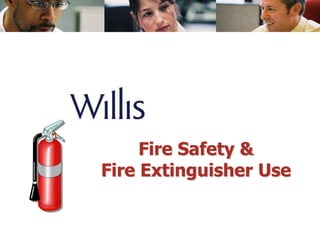Fire_Extinguisher.ppt
- 1. EXTINGUISHER Fire Safety & Fire Extinguisher Use
- 2. Objectives âĒ Understand the combustion process and different fire classes âĒ Understand fire extinguisher types, operating procedures âĒ Understand basic firefighting concepts: âĒ R.A.C.E. âĒ P.A.S.S. Fire Safety & Fire Extinguisher Use
- 3. The Combustion Process Fire Safety & Fire Extinguisher Use âĒ Three components âĒ Need all three components to start a fire âĒ Fire extinguishers remove one or more of the components.
- 4. Fire Classes A Trash Wood Paper C Electrical Equipment B Liquids Grease COMBUSTIBLE METALS D âĒ wood âĒ paper âĒ cloth âĒ etc. âĒ gasoline âĒ oil âĒ grease âĒ other solvents âĒ computers âĒ fax machine âĒ other energized electrical equip. âĒ magnesium âĒ sodium âĒ potassium âĒ titanium âĒ other flammable metals
- 5. Fire Classes (cont.) K Cooking Media âĒ Recently recognized by NFPA 10 âĒ Fires involving combustible oils, lards and fats in commercial cooking. CLASS K FIRES
- 6. Fire Extinguisher Anatomy DISCHARGE HOSE DISCHARGE NOZZLE DISCHARGE ORIFICE BODY DATA PLATE CARRYING HANDLE PRESSURE GAUGE (not found on CO2 extinguishers) DISCHARGE LEVER DISCHARGE LOCKING PIN AND SEAL
- 7. Fire Extinguisher Types âĒ Class âAâ fires only âĒ 2.5 gal. water (up to 1 minute discharge time) âĒ Has pressure gauge to allow visual capacity check âĒ 30-40 ft. maximum effective range âĒ Can be started and stopped as necessary âĒ Extinguishes by cooling burning material below the ignition point. PRESSURIZED WATER A Trash Wood Paper B Liquids Grease C Electrical Equipment A Trash Wood Paper B Liquids Grease C Electrical Equipment
- 8. Fire Extinguisher Types (cont.) âĒ Class âBâ or âCâ fires âĒ 2.5-100 lb. of CO2 (8-30 seconds discharge time) âĒ Has NO pressure gauge--capacity verified by weight âĒ 3-8 ft. maximum effective range âĒ Extinguishes by smothering burning materials âĒ Effectiveness decreases as temperature of burning material increases. CARBON DIOXIDE (CO2) A Trash Wood Paper B Liquids Grease C Electrical Equipment A Trash Wood Paper B Liquids Grease C Electrical Equipment
- 9. Fire Extinguisher Types (cont.) âĒ Class âAâ, âBâ, or âCâ fires âĒ 2.5-20 lb. dry chemical (ammonium phosphate) 8-25 seconds discharge time) âĒ Has pressure gauge to allow visual capacity check âĒ 5-20 ft. maximum effective range âĒ Extinguishes by smothering burning materials. MULTIPURPOSE DRY CHEMICAL A Trash Wood Paper B Liquids Grease C Electrical Equipment A Trash Wood Paper B Liquids Grease C Electrical Equipment
- 10. Fire Extinguisher Summary EXTINGUISHER TYPE WORKS BY EFFECTIVE AGAINST PRESSURIZED WATER CARBON DIOXIDE MULTIPURPOSE DRY CHEMICAL COOLING SMOTHERING SMOTHERING
- 11. Fire Emergency Response R Rescue Alarm Contain Extinguish A C E
- 12. Fighting the Fire Pull the pin Aim low at the base of flames Squeeze the handle Sweep side to side P A S S
- 13. Firefighting Decision Criteria âĒ Know department emergency procedures and evacuation routes âĒ Know locations of extinguishers in your area and how to use them âĒ Always sound the alarm regardless of fire size âĒ Avoid smoky conditions âĒ Ensure area is evacuated âĒ Donât attempt to fight unless: âĒ Alarm is sounded âĒ Fire is small and contained âĒ You have safe egress route (can be reached without exposure to fire) âĒ Available extinguishers are rated for size and type of fire âĒ If in doubt, evacuate! âDONâT ATTEMPT TO FIGHT UNLESS YOU ARE TRAINEDâ
- 14. Summary âĒ Combustion Process (Fire Triangle) âĒ Class A, B, C, D, K fires âĒ Types of portable fire extinguishers: âĒ Operating procedures âĒ Capabilities and limitations âĒ Basic firefighting concepts: R.A.C.E. P.A.S.S. Fire Safety & Fire Extinguisher Use
- 15. Quiz Question 1 âĒ Fire extinguisher marked with an A is used on: âĒ A) oil fires âĒ B) Electrical fires âĒ C) paper material fires âĒ D) none of the above
- 16. Quiz Question 2 âĒ Fire extinguishers marked with a B can be used on: âĒ A) Paper, trash âĒ B) Oil or Grease âĒ C) Electrical âĒ D) Non of the above
- 17. Quiz addendum âĒ How else you can kill a grease fire? A) Smother B) Baking Soda C) A&B
- 18. Quiz Question 3 âĒ Fire extinguisher marked ABC can be used on: âĒ A) Wood, Paper âĒ B) Electrical âĒ C) Liquids and grease âĒ D) All of the above
- 19. Quiz Question 4 âĒ Fire Extinguishers marked with D are used for âĒ A) Combustible chemicals âĒ B) Magnesium âĒ C) Potassium âĒ D) other flammable metals âĒ E) all of the above
- 20. Quiz Question 5 âĒ For what fires is a Halon Fire Extinguisher being used? âĒ Guess 1 âĒ Guess 2 âĒ Guess 3 âĒ Guess 4
- 21. Halon âĒ Halon fire extinguisher is important device to have, especially for emergency situations. It contains a gas that interrupts the chemical reaction that takes place when fuels burn. Halon fire extinguisher is often used to protect valuable electrical equipment since they leave no residue. âĒ Such on expensive computers, server rooms, etc. âĒ Since Halon manufacturing was banned, a hunt has been on for something that works as well. According to the Halon Alternatives Research Corp., more than 20 different kinds of alternatives exist as direct replacements. âĒ Halon Replacement âĒ Those categories are inert gases and halocarbon compounds.




















